Australian stocks have made gains as profit-reporting season has moved into full steam, even as KPMG and a major bank have warned of the fallout of further interest rate hikes.
Disclaimer: this blog is not intended as investment advice.
Key events
Live updates
Markets snapshot at 4:20pm AEDT
By Sue Lannin
Australian dollar: 69.69, up 0.1%
ASX 200: 7,431, up 0.2%
All Ordinaries: 7,629, up 0.2%
Nikkei 225: 27,613, up 0.7%
Shanghai Composite: 3,285, steady
Hang Seng: 21,170, steady
Dow Jones: 34,246, up 1.1%
S&P 500: 4,137, up 1.1%
Nasdaq Composite: 11,892, up 1.4%
FTSE: 7,948, up 0.8%
Brent crude: $US86.02, down 0.7 per cent
Spot gold: $US1858.57, up 0.3 per cent
Iron ore: $US121 a tonne, down 3%
Dollars and cents!
By Sue Lannin
So it was a pretty lacklustre trading day with pretty lacklustre profit results as investors await tonight's US consumer inflation figures, which could determine the future of US interest rates.
Consumer confidence fell back to recessionary levels, but business optimism and conditions improved in January.
The ASX 200 put on one fifth of a percent, with 8 out of 11 sectors higher.
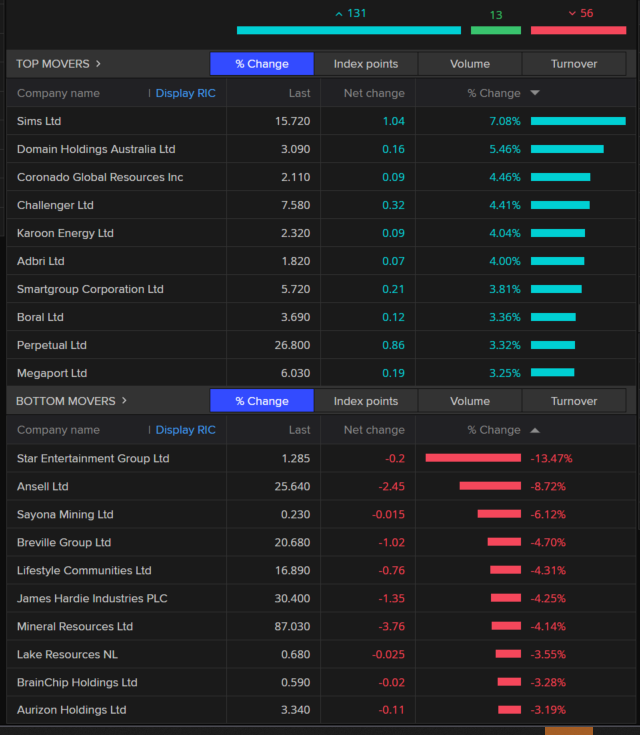
Tech and telecommunications stock were the standouts, while miners and oil and gas stocks weighed on the market.
Metal recycler Sims (+7.1 per cent) did the best, while casino giant Star Entertainment (-13.5 per cent) did the worst.
I hope you enjoyed our markets blog.
Tune in again tomorrow.
And I'll leave you with this delightful video from the National Archives on the 57th anniversary of the switch to decimal currency on February 14, 1966.
Can Philip Lowe survive?
By Sue Lannin
That is the question (apologies to Hamlet).
The Reserve Bank governor has a busy week appearing before two parliamentary committees, where no doubt he will be grilled about his comments that interest rates were unlikely to rise before 2024.
Here's ABC senior business correspondent Peter Ryan's analysis of Dr Lowe's future:
"On the surface it looks as though he'll struggle - but it would be a very big deal for Treasurer Jim Chalmers to dump Mr Lowe - given that he's done what every central bank governor in the developed world has been doing - raising interest rates to pull inflation down - in fact, Philip Lowe has been less aggressive than the US Federal Reserve or the Bank of England which have much higher official rates.
The other big risk is that removing Mr Lowe would raise questions about the RBA's independence from government - and he's raised rates because of the agreed mandate for the RBA - doing whatever is needed to keep inflation."
Have a listen to Peter Ryan's ABC News Radio report:
Business confidence and conditions rebound
By Sue Lannin
The National Australia Bank says business confidence and conditions bounced back last month as Australia saw the first restriction free festive season.
NAB's monthly survey of companies found that conditions picked up in January after three months of easing in late 2022 rising to a "very high level" at +18 index points.
Profitability and employment were "well above average" according to NAB with improved conditions led by wholesale, construction, and transport.
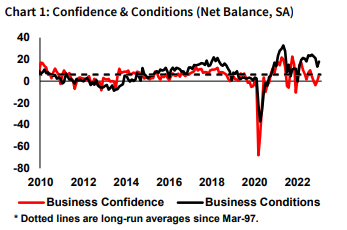
Business confidence increased to around average levels, rebounding from negative readings two months ago.
"Business conditions picked back up in January after three months of softening in late 2022," said NAB chief economist Alan Oster.
"Confidence dipped into negative territory late in 2022, but is now back around the average after rebounding over the past two months."
"The improvement in confidence suggests firms have a more optimistic outlook as concerns about global growth prospects ease, while strong conditions are also providing evidence that the economy is more resilient than previously expected."
Australian stocks run out of steam
By Sue Lannin
The Australian share market has ended off its highs after a mixed bag of profit results from local firms.
The ASX 200 put on 0.1 per cent with most sectors ending higher.
Among the gainers were education stocks, technology, consumer stocks and financials, but miners and oil firms weighed on the market because of lower commodity prices.
Metal recycler Sims Metals (+6.8 per cent) did the best, despite posting a 60 per cent fall in half year profit.
Casino firm Star Entertainment (-13.3 per cent) fell for another day after yesterday's market update which warned of an up to $1.6 billion hit from planned new casino taxes in New South Wales.
IAG boss says insurance premiums to rise 10% this year
By Sue Lannin
Insurance Australia group expects home and car insurance premiums to get more expensive this year as inflation continues to bite.
Higher premiums and investment returns helped the company post a jump in half year profit to nearly $470-million.
Chief executive Nick Hawkins told me in an interview after yesterday's results that premiums are likely to rise another 10-percent over the coming year.
KPMG warns of $16,500 fixed rate mortgage cliff
By Sue Lannin
KMPG Australia chief economist Brendan Rynne says the Reserve Bank's intention to raise borrowing costs at least two more times, could tip some home loan borrowers over the mortgage cliff.
Mr Rynne estimates that more official rate rises could see borrowers, who move from low fixed rate mortgages to variable rate home loans, pay an extra $16,500 in interest payments.
He says if interest rates rise by another 0.75 per cent to 4.1 per cent then household spending could plunge by $20 billion over 2023, with 1 per cent shaved off the value of the Australian economy.
"Since May 2022 average outstanding variable mortgage interest rates have risen by 2.6 per cent, while outstanding 3-years or less fixed rate mortgages have risen by 0.24 per cent (as compared to new 3-years or less fixed rate mortgages which have risen around 2.2 per cent)," Mr Rynne said.
"This differential in the movement in interest rates being charged between outstanding variable and fixed rates means the effect of the previous 9 increases in the cash rate are not yet being fully felt through the domestic economy.
"The average new residential mortgage loan in Australia is around $600,000, so applying 2.75 per cent (being the incremental difference outstanding fixed rate mortgage interest rates and new variable mortgage interest rates) means those households still on fixed rate mortgages will need to pay an additional $16,500 in (after tax) interest payments, once they reset onto a variable rate mortgage – noting of course that variable mortgage holders have already been progressively required to pay higher mortgage interest payments over the past 9 months in line with previous cash rate increases."
"From a whole-of-economy perspective there is currently about $2.1 trillion in property mortgages in Australia, split roughly two-thirds associated with owner-occupiers and one-third investors," Mr Rynne continued.
"A 3 per cent increase in interest rates will mean mortgage holders will need to pay an additional $60 billion in interest payments which otherwise could have been allocated to other forms of spending (or debt reduction)."
Have a read of this earlier analysis of the issue from the ABC's Michael Janda.
Mixed profit results boost or bash share prices
By Sue Lannin
Earnings season is in full swing and reporting firms are making moves on the ASX 200.
Metal recycler Sims (+7.1 per cent) has jumped, despite seeing a 60 per cent fall in net profit for the half year to $101 million because of lower steel prices, weaker customer demand, tighter scrap supply, and higher fuel prices.
Investors also get a lower dividend payout of 14 cents a share for the half year, compared to 41 cents per share for the same time in 2021.
Blood plasma and vaccine maker, and market heavyweight CSL (+0.9 per cent) saw revenue increase by one fifth over the last six months of 2022, but net profit fell by 8 per cent to $US1.6 billion ($2.3 billion).
This was because of the purchase of Vifor Pharma by CSL.
Investors get a record dividend of $US1.07 a share, up from $US1.04 from the same time in 2021.
CSL is upbeat about the year thanks to its blood plasma business and influenza vaccine unit, Seqirus.
"The strong outlook in plasma collections and in the immunoglobulins franchise is expected to continue," the company told the ASX.
"Seqirus is expected to deliver another profitable year. "
"Consistent with the seasonal nature of the business, however, it is anticipated that Seqirus will make a loss in the second half of the year."
Challenger (+4.7 per cent) is also doing well after its earnings came out, even though paper losses from investments halved its profit.
The financial firm says net profit for the first half of the 2023 financial year came in at nearly $123 million, down from $282 million for the same time last year.
However, its life insurance business had a record half with life insurance sales boosted by higher interest rates.
That helped increase annuity sales, which revenue rise from the same time in 2021.
Investors get an interim dividend of 12 cents a share, up 4 per cent from last year.
An annuity is a lifetime or fixed term pension, which gives you guaranteed income for a number of years.
Star Entertainment (-8.4 per cent) has continued to take a hit today, after it slumped by one fifth on yesterday's earnings update.
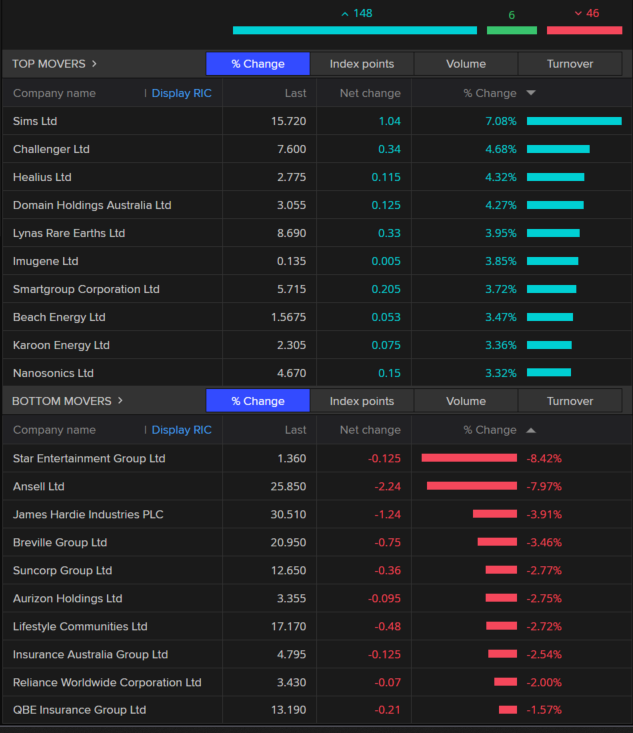
It told the ASX that it expects the new NSW casino tax to cost it up to $1.6 billion, and COVID-19 is also hurting revenue.
Rubber glove maker Ansell (-8 per cent) has also slumped after it saw sales plunge by 17 per cent over the last six months of 2022.
NPAT fell 17 per cent to $64 million for the half year.
That's as living with COVID-19 becomes the norm so less demand for rubber gloves (remember when you couldn't buy them at the supermarket?).
Ansell says strong growth at its industrial unit was offset by weaker sales in healthcare, price reductions, and weaker market conditions.
Construction materials maker James Hardie (-3.9 per cent) is also a big loser after sales fell over the third quarter.
Adjusted net income fell from $US154 million ($221 million) to $US129 million ($185 million) over the third quarter of 2022.
That's because of a sharp slowdown in new home construction in the US, fewer repairs, and lower sales across the globe and the Asia Pacific region.
Real estate investor Dexus (+1.8 per cent) posted lower revenue and profits for the first half of the 2023 financial year.
Net profit slumped 97 per cent from $803 million in the last half of 2021, compared to just $23 million over the last six months of last year, as Dexus was forced to devalue its properties because of falling prices.
But its shares rose because it expects to raise distributions (investor dividends) over 2023.
Dexus said office and industrial building rent collection remained strong, as did occupancy rates, which were more than 90 per cent.
Investors get an interim dividend for the half year of 28 cents per security.
Dexus chief executive Darren Steinberg said the firm had negotiated a lower price of $225 million for AMP's real estate business because completion of the deal was delayed.
"Despite the subdued market conditions, it has been an active six months," Mr Steinberg said.
"With the upcoming addition of AMP's real estate and infrastructure platform, we have refined our vision to be recognised as the leading real asset investment manager in Australia, with the strategic objectives of generating resilient income streams and being identified as the investment manager of choice."
Despite raising prices, electrical appliance maker Breville (-6 per cent) saw flat earnings for the first half of the financial year.
The firm posted a 1 per cent rise in revenue net profit, which was steady at $78 million.
The dividend payout for investors was also steady at 15 cents a share.
Breville's cooking division did the best with US shoppers loving their coffee machines, ovens, and air fryers.
The firm offset high shipping costs and the strong greenback with product price rises.
Chief footy coach (I mean, chief executive) Jim Clayton tried to cheer up disappointed investors with a rousing post match speech.
"In the 1H23 (first half of 2023), as we knocked back the macro headwinds and retailer purchasing behaviour, we adjusted the business model dials to grow EBIT (before tax earnings) more quickly than revenue."
"Given the facts on the ground, it was a half well played."
Are we playing footy or running a home appliance company, Mr Clayton?
NAB raises cash rate forecast to 4.1 per cent
By Michael Janda
National Australia Bank has become the first of the major banks to formally adopt a peak Reserve Bank cash rate forecast above 4 per cent, at 4.1 per cent.
While others, such as ANZ, had flagged the risk of the cash rate rising above 4 per cent, NAB is the first to adopt it as its baseline forecast.
NAB was previously expecting the cash rate to peak at 3.6 per cent, but that was blown out of the water after last week's RBA meeting, where rates were raised to 3.35 per cent with a comment that further increases were expected to be needed.
NAB also just released its monthly business survey, which showed an improvement in both conditions and confidence at the start of this year.
"The economy has remained resilient to both higher inflation and interest rates. Our business survey (out today) and consumer transaction data (tomorrow) indicate this resilience continued in January, and we continue to expect strong prints for wages and inflation to continue in the near term," noted the bank's economics team, led by chief economist Alan Oster.
Echoing recent comments from CBA's economists in raising its peak rates forecast to 3.85 per cent, NAB's analysts do not necessarily think raising rates to those levels is a good idea, they simply now think it's what the RBA will do.
"We still see a strong case for the RBA to look to pause the current hiking cycle soon given the considerable tightening put in place, the 'long and variable lags' and the need to look through some unusual features of the post-COVID normalisation period. However, the RBA's framing of domestic inflationary pressures has clearly changed and as such, we judge it to be unlikely the Board will feel comfortable pausing before May," they continued.
"A cash rate peak above 4% will have a significant impact on economic growth, and we expect GDP to be below 1% over both 2023 and 2024 despite the more optimistic near-term outlook. We also expect the RBA will need to cut interest rates in 2024 to closer to neutral to support growth as inflation moderates."
NAB is expecting the RBA rate rises to come all in a row over the next three months, March, April and May.
We got the latest insights into the RBA's thinking from its Statement on Monetary Policy on Friday, when I spent 90 minutes 'locked-up' at the bank's Martin Place headquarters.
Asking rents jump 2.4 per cent in just a month
By Rachel Pupazzoni
Hello - it's me, Rachel Pupazzoni dropping in with some news on the rental market.
Are you feeling the squeeze?
You're not alone.
Fresh data out today from SQM Research reveals the asking price for rents notched up anther 2.4 per cent in the 30 days to February 12, on average, across the capital cities.
Rents in the capitals have risen 24.7 per cent in the past 12 months.
Across all regions, they're up 17.4 per cent for the year.
Check out this table - only Canberra and Hobart saw a slide in the last month.
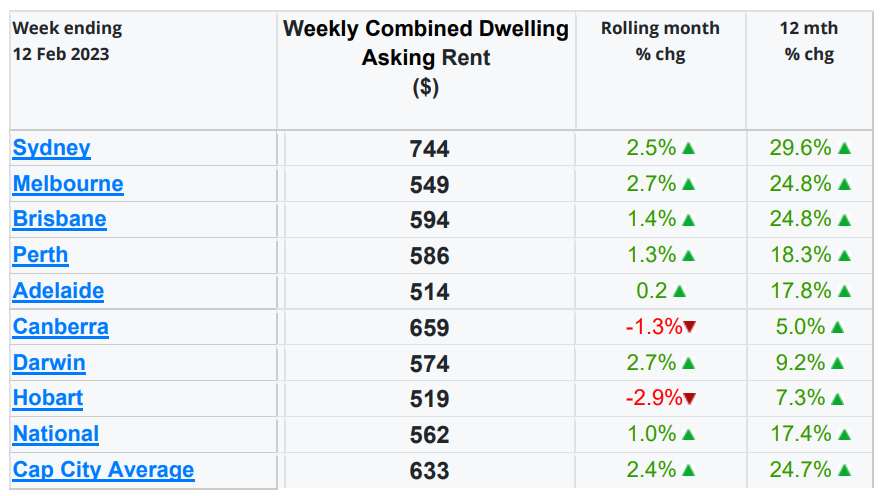
As you can also see from that chart, the national median weekly asking rent is $562, the capital city median is $633 a week.
Louis Christopher, Managing Director of SQM Research said February and March are traditionally the most difficult time for tenants.
"We are expecting a further tightening in rental vacancy rates over the month of February based on evidence that weekly listings have fallen again thus far in the current month.
"Thereafter we are hoping for some relief given the expected increases in dwelling completions and an overall reduction in housing formation."
Rental vacancy rates have again tightened. Take a look at this table.
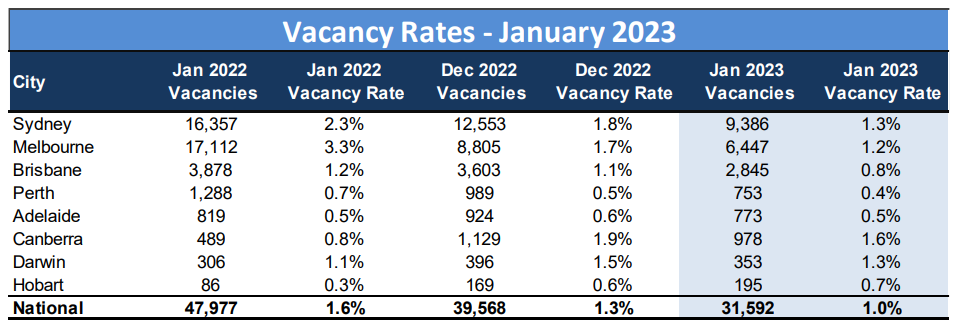
You can easily see the smaller number of available properties in just about every capital city, and for the national average, last month, compared to December and even January last year.
There were 31,592 rental vacancies across the country in January, more than 16,000 fewer than January a year ago.
The tightest rental market is Perth, with a vacancy rate of 0.4 per cent. Followed closely by Adelaide at 0.5 per cent.
Sydney has a slightly higher vacancy rate of 1.3 per cent, but the number of available properties in January 2023 was almost half that of January 2022.
It's this tightness, or lack of availability, that is pushing up asking prices.
There's a lot of demand and not much supply.
As more people migrate here, that equation is unlikely to improve in the immediate term.
Along with the higher interest rates landlords are undoubtedly paying their lenders, and then passing on what they can of those monthly increases to their tenants, it's not a winning situation for renters.
Mr Christopher's longer term outlook isn't too positive, if the Reserve Bank keeps lifting the cash rate, which is currently 3.35 per cent.
"The ongoing surge in rents is pushing up rental yields, especially with falling prices.
"I believe 'would-be' investors will be attracted to higher rental yields in later 2023, provided the cash rate peaks at below 4 per cent.
"However, if the cash rate rises above 4 per cent, it is likely home buyers including investors will largely stay away from the housing market for another year, and so investment dwelling approvals will remain in the doldrums, setting us up for another super tight rental market in later 2024 and 2025."
More rate hikes are expected, with most economists tipping another two or three 0.25 percentage point increases.
Another two would take the cash rate to 3.85 per cent.
Three more hikes and we're at 4.1 per cent.
The next RBA meeting is March 7.
Households may feel like it's a recession, but businesses are still raking in the profits
By Michael Janda
While consumers are bracing for recession, businesses keep on enjoying some of the best trading conditions they've seen in years.
After three months where conditions had eased, NAB's Monthly Business Survey showed they bounced back by 5 points to +18, with trading conditions, profitability and employment all rising and well above average.
"There were strong increases in conditions for 'upstream' sectors such as wholesale, construction and manufacturing, and importantly, conditions in the more consumer-facing industries remained very strong," noted NAB's chief economist Alan Oster.
With conditions improving early in the new year, business owners and managers also felt more optimistic about the outlook, with business confidence climbing 6 points to +6, which is around the long-term average.
"Confidence dipped into negative territory late in 2022 but is now back around the average after rebounding over the past two months," noted Mr Oster.
"The improvement in confidence suggest firms have a more optimistic outlook as concerns about global growth prospects ease, while strong conditions are also providing evidence that the economy is more resilient than previously expected."
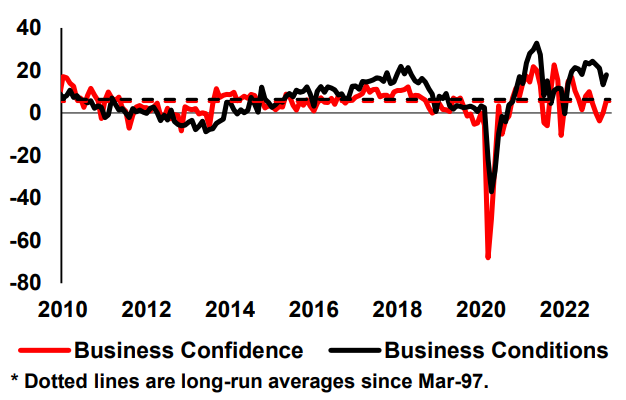
And there are some grounds for that confidence.
"January saw an improvement in forward orders, which is another reason for business confidence to have received a boost," added Mr Oster.
"Capacity utilisation is also once again at quite a high level."
There was also positive news on inflation, although maybe not quite as positive as the Reserve Bank and mortgage borrowers would like to be seeing.
"Measures of cost pressures rose after easing through the second half of last year," said Mr Oster.
"Importantly, survey measures of purchase cost and labour cost growth remain below their 2022 peaks and a downward trend still appears evident. That said there was a noticeable pickup in labour costs in the recreation and personal services sector."
But there is a fundamental question that arises from the juxtaposition of surging business conditions and households who already feel like they're in a recession: how long can the Australian economy keep chugging along if the biggest part of it — households — are in serious distress?
Consumer sentiment plunges back to recession levels on rate rise
By Michael Janda
Good morning, a guest post from me on some big economic news.
The widely watched Westpac-Melbourne Institute Consumer Sentiment Index slumped nearly 7 per cent from an already very low 84.3 in January to a recessionary 78.5 in February.
"At 78.5, the latest Index read is a touch above the 78 read in November but below the low point of the GFC (79.0) and only slightly higher than when the COVID pandemic first hit in April 2020 (75.6)," noted Westpac senior economist Matthew Hassan.
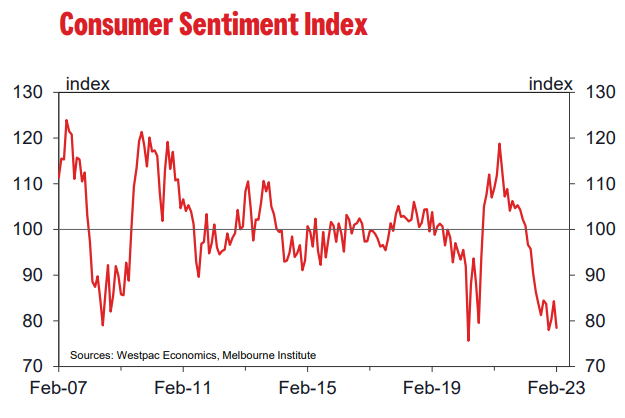
"Prior to that, we need to go back to the deep recession in the early 1990s to find weaker Index readings."
Mr Hassan observed sentiment had slightly rallied around the Christmas period, but it seems any festive cheer was cut short by the Reserve Bank's latest rate rise last week and its firm indication that there would be at least two more still to come.
"Sentiment amongst those surveyed before the [RBA] decision showed a relatively steady 83.5 but sentiment amongst those surveyed after showed a steep fall to 74.8.
"Given that the move was widely anticipated, the negative response likely reflects the clear signal from the RBA governor that further increases can be expected in the months ahead.
"Certainly, more consumers now expect substantial follow-on rate rises. Amongst those surveyed after the RBA decision, 80% expect rates to move higher over the next year with 53% expecting a rise of 1 percentage point or more."
The biggest worry was a plunge in households' current financial position.
"The 'family finances vs a year ago' sub-index dropped 8% in February, to just 62.1 – marking the weakest reading since the depths of the early-1990s recession.
"The index read amongst consumers with a mortgage was just 55.4, down 14.4% since January.
"These are amongst the bleakest responses on this question in the history of the survey, which goes back to the mid-1970s."
My colleague Rhiana Whitson has taken a look at some of the middle-income households with mortgages who are feeling this squeeze.
ASX follows Wall Street
By Sue Lannin
The Australian share market is on the rise after a rally on Wall Street as investors await the latest inflation data from the US.
The ASX 200 index is up 0.6 per cent to 7,464 with all but one sector higher.
Leading the gains are education companies, industrials, real estate, consumer stocks, banks, technology and energy firms.
Metal recycler Sims (+8 per cent) is doing the best, while rubber glove maker Ansell (-7.9 per cent) is doing the worst.
Taylor Swift is the world's richest female entertainer
By Sue Lannin
I reckon we could all learn something from Taylor Swift.
Don't put up with bad boyfriends or partners, do a job you love, and don't worry about what other people think.
Forbes says the US singer/songwriter is the highest paid female performer in the world, earning $US92 million in 2022 thanks to the success of her 10th studio album, "Midnights".
The 33 year old is the only woman among the top ten richest entertainers in the world, ranking 9th behind US actors Tyler Perry and Brad Pitt, and aging rock stars the Rolling Stones, Sting, and Genesis, who topped the list making a cool $US230 million last year.
Puerto Rican rapper Bad Bunny came in at number 10 with $US88 million.
Why isn't Queen Bey, aka Beyonce, in the top ten, I ask you?

Forbes calculates entertainers' total 2022 pretax earnings, minus fees for representation (managers, lawyers, etc), and business operating costs.
I once saw Taylor Swift in concert from my balcony opposite the NIB Stadium in Perth, when I was the ABC's National Resources Reporter.
She was awesome. I loved how she played a whole alot of instruments, had a range of costumes changes, and had deep and meaningful chats with the audience.
Taylor Swift also donates to causes including the Tennessee Equality Project, an LGBTQ advocacy group, the Joyful Heart Foundation for survivors of sexual assault, and RAINN, the Rape, Abuse, and Incest National Network.
What a role model.
Go Taylor! Tell it like it is!
Here's Forbes top 10 list of the world's richest entertainers.
US stocks end higher
By Sue Lannin
Wall Street has ended sharply higher as investors await the latest US consumer numbers, which are out tonight.
The Dow Jones index put on 1.1 per cent, the S&P 500 increased 1.1 per cent as well, while the Nasdaq Composite rose 1.5 per cent.
Ten of the 11 sectors on the S&P 500 gained.
Facebook owner Meta Platforms jumped 3 per cent after the Financial Times reported that the company was preparing to announce more layoffs.
Other tech giants like Microsoft, Nvidia, Amazon, and Apple performed strongly.
Microsoft said it was looking to take on Google and its search dominance through its multi billion dollar partnership with ChatGPT.
Fidelity National Information Services plunged 12.5 per cent following the banking and payments processing company's decision to spin off its merchant payments business.
with Reuters
US stocks rise as investors await inflation numbers
By Sue Lannin
Good morning, welcome to the ABC Markets Blog. I'm Sue Lannin.
Wall Street has rallied overnight as investors await the latest inflation numbers out of the US.
The price of living reached a 40 year high last year, and the Federal Reserve made steep interest rate rises to bring down inflation.
The US Consumer Price Index is expected to increase by 0.4 per cent in January for an annual rise of 6.2 per cent.
The Dow Jones index is up 1 per cent to 34,208 at 7:30am AEDT, while the Australian dollar is higher at around 69.65, up 0.7 per cent.
And later we will get a snapshot of how businesses fared over January, the first restriction free festive season in three years when the National Australia Bank releases its latest monthly business survey.
Grab a coffee and let's go!







